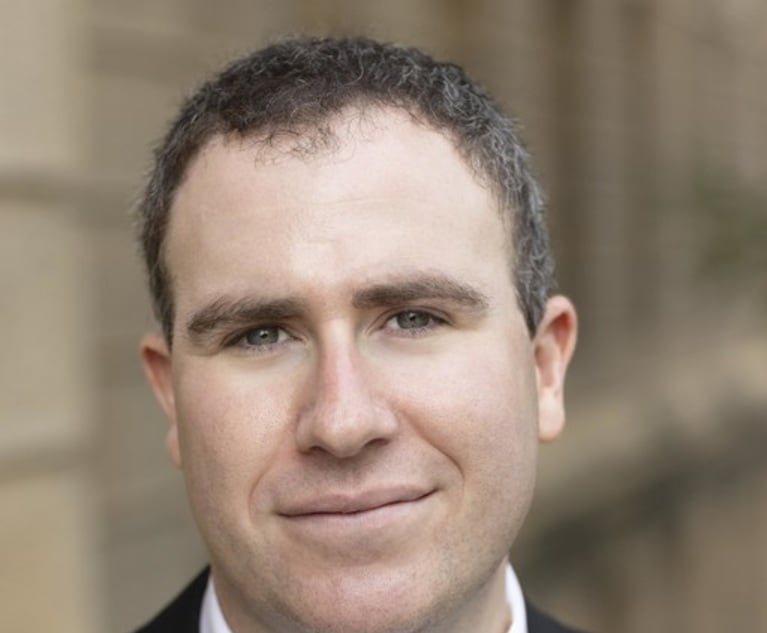The Megafirm as Boutique: PR Lessons Legal Giants Can Learn From the Little Guys
Law Firm Management columnists Steven Andersen and Jamie Diaferia write: Applying the tactics and techniques that work for boutiques to small groups within big firms can yield similar results: more effective brand elevation and more meaningful relationships with the media.
December 21, 2017 at 02:30 PM
6 minute read

As large law firms continue to consolidate, they face increasing difficulty engaging the media proactively or responding to expert source requests. Their conflicts profile is so broad that it often prevents comment on all but the most benign issues. Conversely, boutique firms can punch above their weight in the press because they have fewer clients and more concentrated objectives.
But there's more to it than just being small, nimble and comparatively conflict-free. Boutiques are better than larger firms when it comes to their focus on specific audiences. Larger firms often believe the world is their audience, while boutiques tend to identify specific markets, companies or even individuals, and tailor their messaging and tactics accordingly.
One of the biggest mistakes we see some large firms make is to spread their media engagement across the entire firm, resulting in mile-wide, inch-deep results, and less residual value from one-off media interactions. But applying the tactics and techniques that work for boutiques to small groups within big firms can yield similar results: more effective brand elevation and more meaningful relationships with the media. The trick is for larger firms to think in terms of dozens of focused conversations rather than one over-arching conversation.
That's not to say it's easy. The internal politics of large law firms can be Byzantine and fierce, which can undermine the execution of an effective long-term media strategy. But with the right combination of attributes and approaches, megafirms can employ boutique-like tactics to great effect. Here are some of the necessary ingredients:
Strong Leadership
For a large firm to effectively focus on small internal groups it must have strong leadership that can articulate the strategy and smooth any ruffled feathers of partners and groups who are not the subject of the media plan. At times, the task of telling partners they aren't a focus of the firm's PR strategy has fallen on us as outside consultants, and that rarely goes well. A boutique approach means that leadership decides (and clearly communicates) that media resources will not be spread equally. Some groups and individuals will receive much more attention. This is a function of both strategy (areas the firm wants to target for business development and profile-raising) and reality (topics of inherent media interest). Strong leaders have the ability to earn—or demand—the buy-in necessary to execute the plan.
Clear Objectives and Clearing Conflicts
Large firms will always have a problem with conflicts, but by focusing on smaller teams, media strategists can help find the open space where the firm's conflict profile will not preclude effective engagement. It's easier to build safe talking points for a small group than across a megafirm. The more targeted a media strategy is, the easier it is to avoid conflicts over time, because the spokespeople and PR team will have a clear understanding of no-fly zones and be able to work more efficiently. Media training can also help by educating spokespeople about how to walk the line between saying too much and being useful to a reporter.
Responsiveness and Delegation
Boutiques excel by relying on motivated and responsive spokespeople, who quickly delegate media opportunities they can't take to their peers. Creating a spokesperson hierarchy and passing media opportunities down the chain quickly bolsters conversion rates—the percentage of media opportunities that result in placements. A small group of spokespeople who are well versed in the media strategy and collaborate frequently are able to redirect press queries quickly, meeting more deadlines and improving the quality of messaging. Having an efficient system for clearing conflicts allows for even faster response times, further improving the chances of success.
Depth Is Better Than Breadth
A focus on smaller teams builds familiarity not just among the spokespeople, but also with the media and the agency account executives who connect them. This facilitates quicker responses, trust and lasting relationships. An optimal outcome of any media strategy is for key reporters to know their sources well enough to know when to go to them, and sometimes to contact them directly. It makes life easier for reporters, and a seasoned spokesperson can be trusted to adhere to safe subject matter and not go off topic. Conversely, a spokesperson who only does a couple of interviews per year will not likely forge meaningful contacts, and is more likely to get into deep water if an interview takes an unexpected turn.
Focus on Proactive, Issues-Based Media Campaigns
The narrower a spokesperson's focus for a defined period of time, the more likely the firm will see measurable results within its PR program. With the help of the firm's internal team and outside agency, attorneys can identify a handful of specific issues that are newsworthy, timely, and of interest to their clients. Building a campaign around data breaches within the banking industry, for example, has more value than being a broadly responsive source on cybersecurity. Additionally, the spokespeople are more likely to make time for an interview when they have prepared extensively in advance than if they are caught flat-footed on a random inbound query. Finally, the marketing team can create metrics to document the effectiveness of the campaign to gauge whether it is reaching the target audience, or that it's time to move on to a new issue of importance to clients.
Evolving and Building Over Time
The boutique approach need not be an end in itself. Once a team is well established, the positive momentum will generate more inbound media queries and require less agency time, enabling the agency to ramp up new teams on timely subjects or areas of new priority. Once large-firm “boutique” teams are fully familiar with the process and strategy, they become more independent and require less time and resources from their internal and external communications teams, freeing them to focus on other practice groups.
Any effective law firm media strategy requires an amount of tailoring to the specific objectives, personalities and media involved, but focusing on small teams consistently produces better results. Large firms would do well to remember what it was like to be a boutique and apply the same disciplines to their marketing efforts.
Jamie Diaferia is CEO of the communications firm Infinite Global. Steven Andersen is the firm's vice president for content and client strategy. Both are based in New York.
This content has been archived. It is available through our partners, LexisNexis® and Bloomberg Law.
To view this content, please continue to their sites.
Not a Lexis Subscriber?
Subscribe Now
Not a Bloomberg Law Subscriber?
Subscribe Now
NOT FOR REPRINT
© 2025 ALM Global, LLC, All Rights Reserved. Request academic re-use from www.copyright.com. All other uses, submit a request to [email protected]. For more information visit Asset & Logo Licensing.
You Might Like
View All
Shifting Sands: May a Court Properly Order the Sale of the Marital Residence During a Divorce’s Pendency?
9 minute read
Tortious Interference With a Contract; Retaliatory Eviction Defense; Illegal Lockout: This Week in Scott Mollen’s Realty Law Digest


Court of Appeals Provides Comfort to Land Use Litigants Through the Relation Back Doctrine
8 minute readTrending Stories
- 1Am Law 200 Firms Announce Wave of D.C. Hires in White-Collar, Antitrust, Litigation Practices
- 2K&L Gates Files String of Suits Against Electronics Manufacturer's Competitors, Brightness Misrepresentations
- 3'Better of the Split': District Judge Weighs Circuit Divide in Considering Who Pays Decades-Old Medical Bill
- 4Which Georgia Courts Are Closed Today?—Here's a List
- 5After DEI Rollbacks, Employment Lawyers See Potential For Targeting Corporate Commitment to Equality
Who Got The Work
J. Brugh Lower of Gibbons has entered an appearance for industrial equipment supplier Devco Corporation in a pending trademark infringement lawsuit. The suit, accusing the defendant of selling knock-off Graco products, was filed Dec. 18 in New Jersey District Court by Rivkin Radler on behalf of Graco Inc. and Graco Minnesota. The case, assigned to U.S. District Judge Zahid N. Quraishi, is 3:24-cv-11294, Graco Inc. et al v. Devco Corporation.
Who Got The Work
Rebecca Maller-Stein and Kent A. Yalowitz of Arnold & Porter Kaye Scholer have entered their appearances for Hanaco Venture Capital and its executives, Lior Prosor and David Frankel, in a pending securities lawsuit. The action, filed on Dec. 24 in New York Southern District Court by Zell, Aron & Co. on behalf of Goldeneye Advisors, accuses the defendants of negligently and fraudulently managing the plaintiff's $1 million investment. The case, assigned to U.S. District Judge Vernon S. Broderick, is 1:24-cv-09918, Goldeneye Advisors, LLC v. Hanaco Venture Capital, Ltd. et al.
Who Got The Work
Attorneys from A&O Shearman has stepped in as defense counsel for Toronto-Dominion Bank and other defendants in a pending securities class action. The suit, filed Dec. 11 in New York Southern District Court by Bleichmar Fonti & Auld, accuses the defendants of concealing the bank's 'pervasive' deficiencies in regards to its compliance with the Bank Secrecy Act and the quality of its anti-money laundering controls. The case, assigned to U.S. District Judge Arun Subramanian, is 1:24-cv-09445, Gonzalez v. The Toronto-Dominion Bank et al.
Who Got The Work
Crown Castle International, a Pennsylvania company providing shared communications infrastructure, has turned to Luke D. Wolf of Gordon Rees Scully Mansukhani to fend off a pending breach-of-contract lawsuit. The court action, filed Nov. 25 in Michigan Eastern District Court by Hooper Hathaway PC on behalf of The Town Residences LLC, accuses Crown Castle of failing to transfer approximately $30,000 in utility payments from T-Mobile in breach of a roof-top lease and assignment agreement. The case, assigned to U.S. District Judge Susan K. Declercq, is 2:24-cv-13131, The Town Residences LLC v. T-Mobile US, Inc. et al.
Who Got The Work
Wilfred P. Coronato and Daniel M. Schwartz of McCarter & English have stepped in as defense counsel to Electrolux Home Products Inc. in a pending product liability lawsuit. The court action, filed Nov. 26 in New York Eastern District Court by Poulos Lopiccolo PC and Nagel Rice LLP on behalf of David Stern, alleges that the defendant's refrigerators’ drawers and shelving repeatedly break and fall apart within months after purchase. The case, assigned to U.S. District Judge Joan M. Azrack, is 2:24-cv-08204, Stern v. Electrolux Home Products, Inc.
Featured Firms
Law Offices of Gary Martin Hays & Associates, P.C.
(470) 294-1674
Law Offices of Mark E. Salomone
(857) 444-6468
Smith & Hassler
(713) 739-1250






